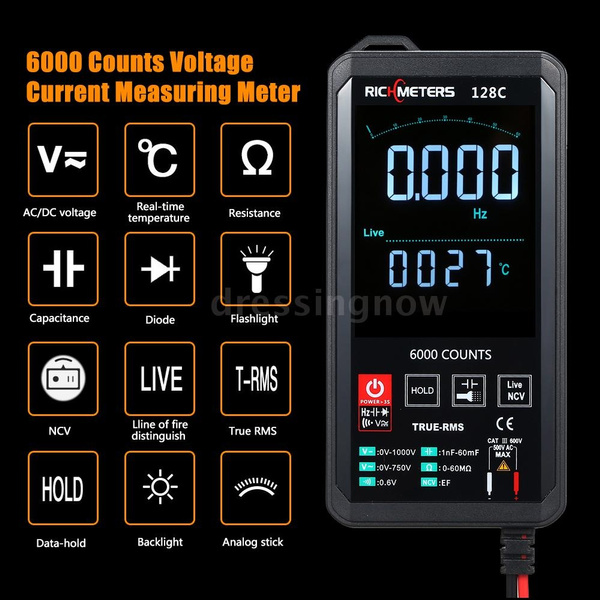585K Deluxe Automotive Meter 45 Test Ranges, 14 Test Functions Test Ranges: DC Volts: 0-320mV, 3.2V, 32V, 320V, 1000V AC Volts: 0-3.2V, 32V, 320V, 750V. Es una herramienta muy profesional me gusto mucho,el envio fue muy rapido el producto es como lo anuncia trae su estuche y ojala me dure mucho tiempo quede muy satisfecho por la compra Read. Deluxe automotive multimeter is a professional grade tool used for diagnosing electrical, computer and engine problems on any vehicle. Kit includes two sets of test leads, RPM pick-up, temperature probe, protective holster, 9V battery, instruction manual and carrying case. Inductive RPM pick-up boasts a five position, adjustable sensitivity switch.
- ESC585M - Deluxe Auto Meter with Fuse Buddy
ESC585M - Deluxe Auto Meter with Fuse Buddy
Nov 02, 2020 Forty-five years ago, Carey Dalbey purchased his first car – and forty-five years later, he still owns it! Automotive Multimeter - Fluke 233 with removable display allows you to connect to one point of the. Kit savings $21.97 (5%) Fluke 116/323 HVAC Combo Kit - Includes Multimeter and Clamp Meter. Professional grade tool used for diagnosing electrical, computer and engine problems on any vehicle.Diagnose electrical, engine, and computer problems in any vehicle with the professional ES Deluxe Automotive Meter With RPM & Temperature. This equipment offers 45 test ranges, dual fuse protection, and 14 test functions. It features RPM for DIS and standard ignitions and includes RPM pick-up.
- Price:
- $159.95
- SKU:
- ESC585M
- Vendor:
- Brand:
- Electronic Specialites
- Condition:
- Weight:
- Rating:
- Availability:
- Shipping:
- Current Stock:
- Gift Wrapping:
Product Description
ES621 10A Replacement Fuse
ES625 .5A Replacement Fuse
Find Similar Products by Category
Every car has one, and without it you'd be going nowhere! When you turn the key and hear a click, or nothing at all, here's a few tests you can do with a simple multimeter.

How many volts should a car battery have?
A good healthy car battery should register about 12.6 volts. Due to the way batteries discharge it's important that you test the battery after it's been sitting for at least an hour to get what's called the 'resting voltage'. Leave the car overnight and test before you start the car in the morning to get a really accurate gauge of the health of your battery.
If you've recently been for a drive, as long as the charging system is working correctly, the battery is likely to give a higher reading than the resting voltage, and so could be misleading.
Testing a battery with a multimeter is a simple process. The first thing to do is make sure you can access the battery terminals (the metal connections on the top or front of the battery).
Batteries are commonly located in the engine bay to one side of the engine. If the battery is not immediately obvious when you open the hood, consult the owner's manual. In modern cars, the battery will often have a plastic cover which will unclip, hinge up, or occasionally require removing with a few bolts or screws. There may also be a red cover over the positive (+) terminal that will lift off or snap open too. Once the battery is exposed be extremely careful that nothing metal touches the terminals and causes a short, so don't set wrenches or other tools on top of the battery.
How to check car battery with multimeter
The first test with your multimeter will measure DC voltage, indicated with a solid line and a dashed line above a letter V. Set the dial to 20, which will allow you to accurately measure between 0-20 Volts.
Touch the red probe to the positive terminal, and the black probe to the negative terminal. The terminals will be marked + and -, and often color coded red for positive and black for negative. If you're getting a reading with a minus in front of it (-12.6 rather than 12.6) you've got the probes the wrong way round!
As we've discussed the resting voltage should ideally be no lower than 12.6V. Bear in mind that when a battery goes down to 12.2V it's actually only 50% charged, and below 12V it's classed as discharged!
One thing to bear in mind is that all modern cars experience 'parasitic loss' where something electrical drains the battery even with the engine turned off. Even with all the lights and engine turned off, the digital clock, computer, and several other systems use some power. If you suspect this is killing your battery during storage, you can either disconnect the battery, or remove the battery from the car entirely.
If you get less than 12.6 volts, disconnect the battery and fully charge it with a battery charger. Then test after an overnight rest. If the battery holds a charge when it's not connected to the car – something is draining the battery far faster than the computer memory and digital clock.
How to check the alternator with multimeter
The alternator's job is to produce electricity and charge the battery. As you drive along the belt driven alternator takes over the role of delivering power to the car's electrical systems and also recharges the battery.

So with the engine running (and being mindful about moving parts) conduct the same battery test as above with your multimeter. A healthy charging system should give a reading of between 13.8V and 14.4V at regular idle speed.
Anywhere outside that range and your car's either under, or over charging – both of which will shorten the battery life and require further investigation. For more on the charging system in your car, see When Good Alternators Go Bad (and Why).

How to test car battery for dead cells
Often times a battery won't go bad all at once, but one or several of the cells that make up the battery will go dead. When this happens you tend to first notice it as a slow to crank condition when starting the car.
Most new car batteries are of the sealed 'maintenance free' variety, but some older batteries allow you to access the individual cells. The cells will either have individual caps, or a plastic cover that clips over all, or several of the cells. The cells contain a mix of water and sulfuric acid, so you don't want to be messing around inside them, and avoid getting any liquid on your skin.
Es 585 Multimeter Manual Pdf
To test each cell, you need a hydrometer-style battery tester that measures the specific gravity of the battery acid. Based on the number of balls floating, you can tell whether the cell is dead or not. However knowing a cell is dead is of no more use to you than knowing that the battery won't hold a 12.6 volt charge, because you can't fix it. So, a test of the resting voltage is just as effective a diagnosis.
Es 585 Multimeter Manual
Pro Tip: Before you disconnect your battery make sure you know the anti-theft code for your stereo – You may find it won't work when you reconnect it otherwise!
